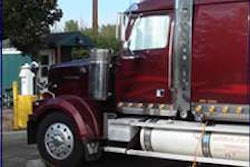Mack’s 13-liter MaxiCruise on-highway engine makes the sweet spot even sweeter.
When Mack unveiled its MaxiDyne engine in 1965, it challenged the standard premise that diesels run best close to the top of the engine’s rpm range. The engine operated in a range from 1,050 to 2,100 rpm and produced almost as much power running at 1,050 as it did at 2,100.
“That was so-called constant engine power,” says David McKenna, Mack’s director of powertrain sales and marketing, and it was achieved via “a broad expanse of torque at the bottom end.” Where torque tapered, horsepower picked up the slack.
Mack’s modern on-highway MaxiCruise, the 13-liter MP8, operates on a similar notion, though executed slightly differently. “Customers always look for that bottom-end grunt that Mack engines offer,” McKenna says. “We had to maintain that.”
Where it distinguishes itself from its predecessors, though, is in its horsepower offerings relative to the engine’s rpm level. McKenna says Mack dubbed the MP8 a “hump horsepower engine,” meaning it offers more horsepower when running at cruise speed than at higher rpm levels.
“At 1,400 rpm, you could conceivably have 505 hp, yet at 1,800 rpm, you might be down to 420,” he says. “It encourages drivers to operate closer to what benefits them. It offers them a lot of power in and around the sweet spot.”
That, matched with the engine’s weight and horsepower combinations, can be beneficial for single-truck operations, McKenna says.
“For owner-operators, to me, the key is maximizing the ability to make money,” he says. “Whether you choose to or not, that’s your business, but this engine is designed to do that. We’ve kept weight substantially lower than other 14-16-liter engines, and we’re able to give the driver 500-plus horsepower and 1,700 lb.-ft. of torque in an engine that weighs 2,600 pounds.”
Mack also had to distinguish the engine from its parent company’s offerings. Though it shares some design elements with Volvo’s on-highway engine line, Mack’s engines use different parts and perform differently, McKenna says, because of the MaxiCruise’s torque and power curves.
Another recent change to the engine was its migration from exhaust gas recirculation technology to selective catalytic reduction. McKenna says Mack dialed back the EGR rate substantially and increased the engine-out NOx to help keep the diesel particulate filter cleaner.
Landstar owner-operator Alphonso Thompson purchased a 2011 Mack Pinnacle last year, equipped with an MP8. Though he’s put less than 100,000 miles on it, he says the truck’s power has surprised him. “I always said the emissions restrictions were going to tie the truck down,” he says. “I’ve been impressed with its power so far.”
In the past, Thompson’s run 300-hp and 454-hp trucks, but this time he opted for the 505-hp model. “It’s a little bit bigger engine, but it’s made for over-the-road guys like me,” he says. He gets between 5.8 and 6 mpg, but is “looking for that to get a little better once everything gets broken in.”
Because the engine uses SCR, it requires diesel exhaust fluid, but the payoff is worth the cost of DEF, Thompson says. “My pipes are the same color as they were when the truck was new,” he says. “Even though it’s an extra cost, it has its benefits. In this day and age, everybody has to be ‘clean, clean, clean.’ I think this engine is a pretty good option.”
Putting the focus on fuel economy
In addition to turning the MaxiCruise MP8 into an SCR engine, last year Mack also developed another engine, the Econodyne. It’s built “strictly as a fuel-economy engine,” says Mack’s David McKenna.
It’s available in the same horsepower ratings as the MaxiCruise, but uses a more conventional torque curve through the engine’s rpm range.
The engine’s attempts at improving fuel economy stem from its ability to offer an extra 200 lb.-ft. of torque, allowing drivers to stay in top gear longer. If the driver spends four seconds or more at full throttle at or below 1,300 rpm, the extra torque shows up.
“It’s been proved empirically the longer you can keep a truck in top gear, the better fuel economy is going to be,” McKenna says. “This engine sort of rewards drivers for operating it the way it should be operated.”
MAXICRUISE MP8
Configuration: Inline six-cylinder
Displacement: 13 liters (780 cu. in.)
Bore and stroke: 5.16 x 6.22 in.
Governed speed: 1,800-2,100 rpm
Horsepower ratings: 415, 445, 505
Lubrication system capacity: 33 qt.
Torque ratings: 1,460 to 1,760 lb.-ft.










